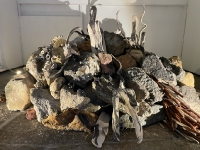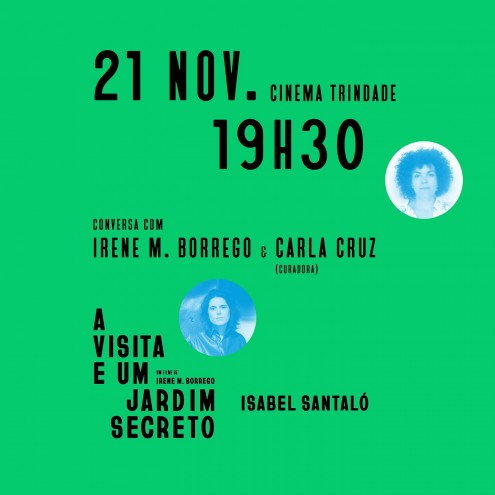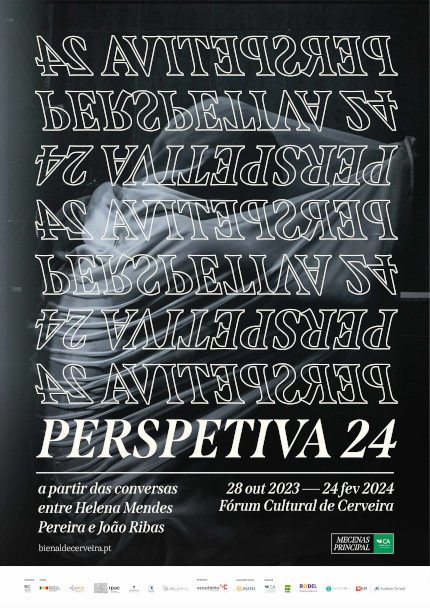-
Q&A Cinema Trindade
23/11/2023 -
Perspetiva 24
17/10/2023«Perspetiva 24»
Curated by Helena Mendes Pereira e João Ribas
Fórum Cultural de Cerveira 28 oct 2023 – 24 feb 2024with Conjugate the Plural
-
Zonas de Transição
17/10/2023Transition Zones – Works from the PLMJ Foundation Collection
Torreão Nascente da Cordoaria Nacional (TNCN).A joint initiative with EGEAC and the Municipal Galleries of Lisbon, this exhibition brings together around 150 works by more than 90 artists represented in the PLMJ Foundation’s collection, with a particular focus on the last 15 years. With this exhibition, we want to share part of the history of the collection, celebrate art and artists, and reaffirm our commitment to culture and the community.
Curated by João Silvério, Transition Zones (Zonas de transição) is an exhibition project that presents a broad vision of the PLMJ Foundation’s collection. The collection began in 2001 and covers a period of more than four decades of artistic production from the world of the Community of Portuguese Speaking Countries (CPLP). The selection includes artists of different generations and from different countries, from areas of the collection such as painting, drawing, artist’s book, sculpture, installation, photography and video, the latter two being central to the development of the collection. The design and organisation of the exhibition pay particular attention to themes such as the representation of the body, architecture and the written word, in a meeting of territories and aesthetic, poetic and political imaginaries that characterise the collection.
Artists represented in the exhibition
Adriana Molder; Albano Silva Pereira; Alice Geirinhas; Ana Jotta; Ana Manso; AnaMary Bilbao; Ana Vidigal; Ana Pérez-Quiroga; André Cepeda; André Gomes; Ângela Ferreira; António Júlio Duarte; António Olaio; Armanda Duarte; Augusto Brázio; Bruno Pacheco; Carla Cruz; Carlos Bunga; Carlos Correia; Cecília Costa; Daniel Blaufuks; Espacialistas + Gonçalo M. Tavares; Fátima Mendonça; Felipe Barbosa; Fernão Cruz; Fernanda Fragateiro; Filipa César; Francisco Queirós; Gabriela Noujaim; Gonçalo Barreiros; Gonçalo Mabunda; Helena Almeida; Horácio Frutuoso; Isabel Baraona; Isabel Madureira Andrade; Isabel Simões; Jéssica Gaspar; João Galrão; João Louro; João Maria Gusmão e Pedro Paiva; João Onofre; João Paulo Feliciano; João Pedro Vale e Nuno Alexandre Ferreira; João Penalva; Jorge Dias; Jorge Molder; José Loureiro; José Maçãs de Carvalho; José Pedro Croft; Julião Sarmento; Kiluanji Kia Henda; Kester; Lino Damião; Luísa Cunha; Maimuna Adam; Mafalda Santos; Manuel Botelho; Manuel Rosa; Maria José Cavaco; Mariana Gomes; Maria Durão; Maria Oliveira; Márcio Carvalho; Marta Soares; Mauro Cerqueira; Mauro Pinto; Miguel Ângelo Rocha; Miguel António Domingues; Miguel Palma; Mónica de Miranda; Noé Sendas; Nú Barreto; Nuno Cera; Nuno Sousa Vieira; Paulo Brighenti; Paulo Kapela; Paulo Catrica; Paulo Quintas; Pedro Alfacinha; Pedro Barateiro; Pedro Cabrita Reis; Pedro Calapez; Pedro Casqueiro; Pedro Gomes; Pedro Valdez Cardoso; Pedro Vaz; Rui Calçada Bastos; René Tavares; Ricardo Jacinto; Rita Gaspar Vieira; Rita GT; Rodrigo Oliveira; Rosana Ricalde; Rui Chafes; Rui Sanches; Sara Bichão; Susana Mendes Silva; Susanne Themlitz; Thandi Pinto; Tito Mouraz; Vasco Araújo; Vasco Barata; Vera Mota; Yonamine.
AAPA
Biennial
Braga
Coimbra
colaboração
collaboration
community
drawing
Europe
exhibition
Exposição
Fair
feminism
festival
Finding Money
gallery work
gender
Guimarães
instalação
installation
institutional critique
intervention
Lisboa
London
Madrid
Ovar
pamphlet
participation
performance
politics
Porto
postcard
Poster
public art
Residency
Rotterdam
sculpture
solo show
sound
Sousveillance
surveillance
Talk
theatre
video
Vienna






